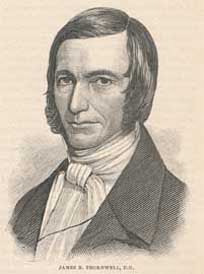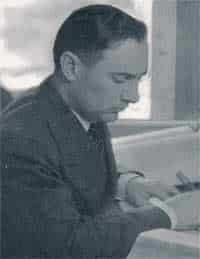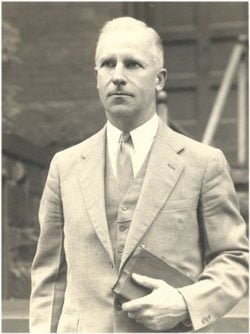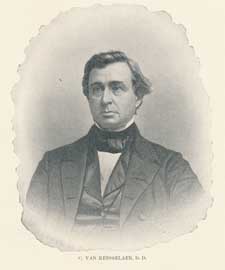 Yesterday we had brief mention of Dr. Cortlandt Van Rensselaer [1808-1860, pictured at right], who was noted for a letter he had written to the Rev. James Henley Thornwell. Today for our Sunday Sermon we will look at a portion of a sermon that Dr. Van Rensselaer delivered in memory of the Rev. George Washington Doane, an Episcopalian Bishop.
Yesterday we had brief mention of Dr. Cortlandt Van Rensselaer [1808-1860, pictured at right], who was noted for a letter he had written to the Rev. James Henley Thornwell. Today for our Sunday Sermon we will look at a portion of a sermon that Dr. Van Rensselaer delivered in memory of the Rev. George Washington Doane, an Episcopalian Bishop.
Dr. Van Rensselaer served four years as a pastor in Burlington, New Jersey, and it was during this time that he came to know Bishop Doane. Leaving the Burlington pulpit, Van Rensselaer was called to head the PCUSA’s Board of Education, and there he served for fourteen years. Some measure of the friendship between these two men is thus marked by the fact that this sermon came thirteen years after Van Rensselaer left Burlington. Bishop Doane died in April of 1859; Van Rensselaer would himself pass into eternity just fifteen months later.
Over the last ten or twelve years, I have gotten the impression from my reading that nineteenth-century American Protestants tended to be evangelical Christians first, and only attached to their various denominations in a secondary way. A number of examples could be produced, and this sermon is another good example. A strictly evangelical sermon, delivered by a Presbyterian, in memorial to the life and ministry of an Episcopalian! Would or could we even have such a thing today?
The closing comments of Van Rensselaer’s sermon follow:
LESSONS AT THE GRAVE
Before separating, it is well for us, as immortals, to try to learn a few lessons at a Bishop’s grave.
I. Death comes alike to all. My hearers, are you ready to die? Ye of gray hairs, or in vigorous manhood, or in sublime youth, are ye prepared to meet your God? What a solemn thing to be coffined away from human sight, and then lowered down into a chamber, digged out for our last abode, with six feet of earth thrown on to roof it in? Ye living mortals, your funeral day is at hand. Come, prepare for the change; for the change is coming.
II. The honours of this world are fleeting nothings. Crown and crossier, sceptre and cross, vestment of distinction and laurel of renown, are all left behind. When the spirit enters its new existence, if it has been redeemed by blood, it carries with it graces of righteousness, which abide forever. But earthly honour and power, the elevation of outward position, the distinctions of learning and rank, all the superficial framework of the vanity of the world, and all its real glory, whatever there be of it, sink away like a vision of delirium. O, godly poor, be contented! Worldly, or unworldly high ones, fear!
III. Let us grow in circumspection, both ministers and people. Religion cultivates prudence. It enjoins its disciples to “walk in wisdom towards them that are without.” In our unguarded moments, we are in danger of going astray, and often are led to do what we have charged ourselves to forbear. Human resolutions are frail; but God can, and will, give strength to all whose eyes, in tearful penitence, plead for help and mercy. A single act of indiscretion, or of guilt, may be followed by the heavy retribution of embittered calumny, or unrelenting exaggeration. The officers of the Church, above all others, should be above suspicion. “See that ye walk circumspectly; redeeming the time, because the days are evil.”
IV. Let us not be weary in well-doing. Activity is the law of Christian life. The new birth inspires high motive, and nurtures the spirit of self-denial and suffering. Church idlers are a spectacle to the profane. Shall Christians be “created unto good works,” and not perform them? Shall the grace of the Spirit plead in vain? Shall the example of Christ and the blood of his cross be without efficacy to those who profess to follow the one and to be washed in the other? Brethren, “be not weary in well-doing; for in due time ye shall reap, if ye faint not.”
V. “Charity is the bond of perfection.” Love binds all the graces together; and all the graces are formed out of love. The same Divine likeness is impressed upon them all. Charity covereth a multitude of sins. Charity suffereth long, and is kind. If our fellow creatures transgress, can they not be forgiven? Does not God, for Christ’s sake, pardon the penitent? And shall man be forever hard-hearted and unrelenting against his fellow-sinners? May the Lord clothe us, dear brethren, with every grace, and girdle our garments with love! Charity is compatible with Truth and Justice. “Put on charity, which is the bond of perfectness.”
VI. A man’s work survives his life. A useful and active Christian leaves imperishable memorials. Good done in the name of the Lord Jesus Christ, can never be buried. It survives with a multiplication of its power. It sends down accumulated influences to distant generations. It lives forever. Sermons preached, institutions established, catechisms taught, aid given to the poor—all virtue, of whatever kind, lives in perpetuity. And so, alas! does evil, unless counteracted and circumvented by Providence and grace.
VII. Let us learn, as Churches, to sympathize with each other more. If we all love Christ, what interests have we apart? Why need we misrepresent each other’s doctrines, depreciate each other’s worthies, and call in question each other’s piety. If there be separate folds, is there not also a large field in common where all the good Shepherd’s sheep may feed on the green pastures and drink the pure waters? I have had my share of controversy, but have never relished it, and dislike it with increasing aversion. We need not, we must not surrender our principles; but what is called principle is often nothing more than denominational interest. Brethren, our hearts beat together today. We mourn in sympathy. Can we not in sympathy live together and work together?
VIII. The passport to Heaven consists, not in merit or station, but in simple faith. The Gospel condition of eternal life is the same to men of all nations and generations. The Bishop enters heaven in the same way with the sexton. The saints become one in Jesus Christ, in the same true and living way, opened alike to every creature. In dying, the Christian goes back to the first principles of his religion. As he began with Christ, so he ends with Christ. The conquest of death is won through faith. No forms and ceremonies; or liturgical repetitions; or imposition of hands; or baptismal, or immersional regeneration; or Church connection; or office-bearing, be it that of Pope, Bishop, Priest, Deacon, or Minister, Elder, Superintendent, or Class-leader—ever have, or ever will, or ever can, save a single soul. Bishop Doane, in his dying hour, had a clear conviction that Christ was the only hope for a sinner, lost by nature. This doctrine was fundamental in his theology; and no one taught it more beautifully than in that immortal hymn of his own composition:
“Thou are the Way; to thee alone,
From sin and death we flee;
And he who would the Father seek,
Must seek him, Lord, by thee.
“Thou are the Truth; thy word along
True wisdom can impart;
Thou only canst inform the mind,
And purify the heart.
“Thou art the Life; the rending tomb
Proclaims thy conquering arm,
And those who put their trust in thee,
Nor death nor hell shall harm.
“Thou art the Way, the Truth, the Life;
Grant us that way to know;
That truth to keep, that life to win,
Whose joys eternal flow.”
May Heaven grant to us all, brethren, the right to live and die in the truth of the Apostolic Church, and to find our title to Heaven in the apostolic words: “Believe on the Lord Jesus Christ, and thou shall be saved.”
[excerpted from A Funeral Sermon on the Occasion of the Death of Bishop Doane. Preached in the Presbyterian Church, Burlington, N. J. , on May 1st, 1859, by Cortlandt Van Rensselaer. Published by J. M. Wilson, Philadelphia, 1859.]
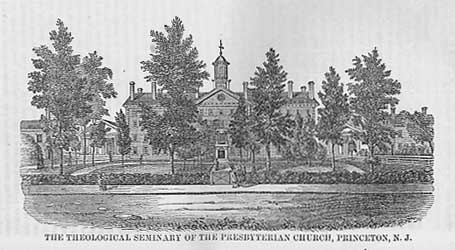 On August 12, 1812, while the nation was again at war with Great Britain, people packed the town’s Presbyterian Church for the inauguration of Dr. Archibald Alexander as the first professor of Princeton Theological Seminary. He had been chosen by the General Assembly. He preached his inaugural sermon for the worshipers, and took his vows regarding the confessional standards and the Presbyterian form of Government. The seminary had begun, with three students. It would soon find its footing and began to send out laborers into the fields, which were white unto harvest.
On August 12, 1812, while the nation was again at war with Great Britain, people packed the town’s Presbyterian Church for the inauguration of Dr. Archibald Alexander as the first professor of Princeton Theological Seminary. He had been chosen by the General Assembly. He preached his inaugural sermon for the worshipers, and took his vows regarding the confessional standards and the Presbyterian form of Government. The seminary had begun, with three students. It would soon find its footing and began to send out laborers into the fields, which were white unto harvest.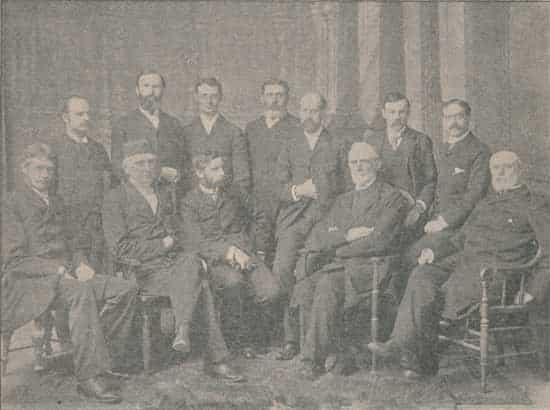 Faculty of the Princeton Theological Seminary, 1896: G.T. Purves, J.D. Davis, G. Vos, B.B. Warfield, W.B. Greene, Jr., J.H. Dulles, H.W. Smith, F.L. Patton, W.M. Paxton, C. Martin, W.H. Green, J. De Witt.
Faculty of the Princeton Theological Seminary, 1896: G.T. Purves, J.D. Davis, G. Vos, B.B. Warfield, W.B. Greene, Jr., J.H. Dulles, H.W. Smith, F.L. Patton, W.M. Paxton, C. Martin, W.H. Green, J. De Witt.

